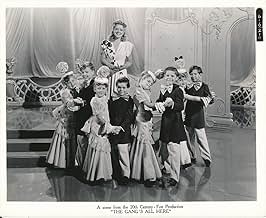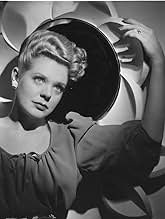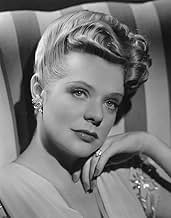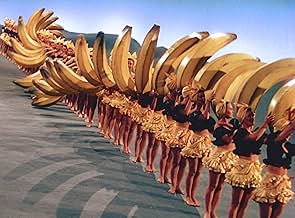CALIFICACIÓN DE IMDb
6.6/10
2.2 k
TU CALIFICACIÓN
Agrega una trama en tu idiomaA soldier falls for a chorus girl and then experiences trouble when he is posted to the Pacific.A soldier falls for a chorus girl and then experiences trouble when he is posted to the Pacific.A soldier falls for a chorus girl and then experiences trouble when he is posted to the Pacific.
- Dirección
- Guionistas
- Elenco
- Nominado a 1 premio Óscar
- 2 premios ganados y 1 nominación en total
Benny Goodman and His Orchestra
- Benny Goodman's Orchestra
- (as Benny Goodman Orchestra)
Don Anderson
- Club New Yorker Patron
- (sin créditos)
Leon Belasco
- Waiter
- (sin créditos)
Brooks Benedict
- Club New Yorker Patron
- (sin créditos)
Lee Bennett
- Club New Yorker Patron
- (sin créditos)
William A. Boardway
- Club New Yorker Patron
- (sin créditos)
Opiniones destacadas
Some of ALICE FAYE's close-ups in THE GANG'S ALL HERE convince me that Technicolor was made to show off the charms of certain actresses--as Fox well knew with such beauties as Betty Grable and Linda Darnell under contract. Faye's blue eyes get all misty-eyed when she sings a ballad--and when she's supported by someone like CARMEN MIRANDA for colorful contrast, well--you can bet it's a musical worth seeing and hearing.
In this case--mostly worth seeing because of Busby Berkeley's magical treatment of all the musical numbers. Who can ever forget CARMEN MIRANDA and all those waving bananas??? Or the kaleidoscope effect of several top numbers in an imaginative use of color and camera effects, the kind that only Berkeley was a master of.
The flimsy plot is strictly by the numbers and practically non-existent in a boy meets girl, boy loses girl, boy wins girl sort of way. JAMES ELLISON is a poor substitute for Fox's contract player John Payne, who must have been busy on another assignment when the cast was assembled. And PHIL BAKER is totally wasted.
But it's not too much of a distraction when the gaudy splashes of color, music and just downright fun provided by Faye, Miranda, Eugene Palette, Edward Everett Horton and Charlotte Greenwood come to the fore.
This is typical Fox escapism made for entertainment during World War II when the troops were all salivating over the Fox pin-up girls. Alice Faye is at her most attractive with her warm contralto voice showcased in a couple of hokey ballads and when she gazes heavenly toward some unseen spirit she practically melts the camera lens. She's luscious and so is the film.
And if you're a CARMEN MIRANDA fan, you can't afford to miss this one. Her "Tutti Frutti" number is a knockout and Benny Goodman and his band provide solid musical back-up. Just don't expect reality to butt in at any point during the silly plot.
Trivia note: That's ADELE JERGENS in the background of girls.
In this case--mostly worth seeing because of Busby Berkeley's magical treatment of all the musical numbers. Who can ever forget CARMEN MIRANDA and all those waving bananas??? Or the kaleidoscope effect of several top numbers in an imaginative use of color and camera effects, the kind that only Berkeley was a master of.
The flimsy plot is strictly by the numbers and practically non-existent in a boy meets girl, boy loses girl, boy wins girl sort of way. JAMES ELLISON is a poor substitute for Fox's contract player John Payne, who must have been busy on another assignment when the cast was assembled. And PHIL BAKER is totally wasted.
But it's not too much of a distraction when the gaudy splashes of color, music and just downright fun provided by Faye, Miranda, Eugene Palette, Edward Everett Horton and Charlotte Greenwood come to the fore.
This is typical Fox escapism made for entertainment during World War II when the troops were all salivating over the Fox pin-up girls. Alice Faye is at her most attractive with her warm contralto voice showcased in a couple of hokey ballads and when she gazes heavenly toward some unseen spirit she practically melts the camera lens. She's luscious and so is the film.
And if you're a CARMEN MIRANDA fan, you can't afford to miss this one. Her "Tutti Frutti" number is a knockout and Benny Goodman and his band provide solid musical back-up. Just don't expect reality to butt in at any point during the silly plot.
Trivia note: That's ADELE JERGENS in the background of girls.
20th Century Fox pulled out all the stops for this Technicolor musical, "The Gang's All Here," directed by Busby Berkeley. There is a song at least every few minutes, wonderful singing, dancing, and comedy galore, and an absolutely threadbare plot. The story is of no consequence - the music is the thing, along with Carmen Miranda's gaudily-costumed numbers and delightful butchering of the English language.
This film was made to bolster spirits during the war and to sell war bonds, which is dealt with in part of the plot. I can't imagine anyone walking out of the theater with anything but a smile on their face.
Alice Faye is lovely and sings beautifully in her contralto, her main number being "A Journey to a Star." Miranda's big number, of course, is the classic "The Lady in the Tutti Frutti Hat" with the fabulous illusion at the end. Charlotte Greenwood gets to dance in "The Jitters" and she, Edward Everett Horton, and Eugene Palette provide excellent support. Benny Goodman's band is a standout, and I've always been a sucker for Benny's smooth, relaxed singing voice. Busby Berkeley's numbers are spectacular, particularly the finale - but somehow, I can't see it being done on someone's lawn! I agree with one of the posters, these Fox musicals need to be packaged into a collection and put out on DVD. They're too much fun to miss.
This film was made to bolster spirits during the war and to sell war bonds, which is dealt with in part of the plot. I can't imagine anyone walking out of the theater with anything but a smile on their face.
Alice Faye is lovely and sings beautifully in her contralto, her main number being "A Journey to a Star." Miranda's big number, of course, is the classic "The Lady in the Tutti Frutti Hat" with the fabulous illusion at the end. Charlotte Greenwood gets to dance in "The Jitters" and she, Edward Everett Horton, and Eugene Palette provide excellent support. Benny Goodman's band is a standout, and I've always been a sucker for Benny's smooth, relaxed singing voice. Busby Berkeley's numbers are spectacular, particularly the finale - but somehow, I can't see it being done on someone's lawn! I agree with one of the posters, these Fox musicals need to be packaged into a collection and put out on DVD. They're too much fun to miss.
No doubt about it, the movie's a cast of characters collected in someone's goofy heaven—Carmen Miranda, Busby Berkeley, and Edward Everett Horton, all together in one padded cell. Throw in leggy Charlotte Greenwood and froggy Eugene Palette, and there's enough colorful types for ten musicals. Aside from the conventional plot, this 1943 trip to bizzaroland doesn't disappoint for sheer wackiness.
Of course, there's Miranda's infamous arching bananas replete with the recumbent girls, all of which could have sent Dr. Freud into terminal overload. Really, how the carnally obsessed Berkeley managed to stay this side of the censor is still puzzling. And catch that final number with the disembodied heads and Palette croaking out a song. I'm just wondering what Berkeley's dreams were like. They couldn't be any weirder than what's there on the screen.
Then there's the top of Miranda's head sporting more pointy architecture than the Manhattan skyline. And catch her wardrobe—somewhere there's a dozen circus clowns without their costumes. After that, add a few lines of her hilariously fractured English, and she's a whole wonderful show in herself. Too bad her personal life was apparently so unhappy.
Great color photography, along with a soulful Alice Faye. Even the pretty much unknown James Ellison seems a good stand-in for the boys in uniform. No doubt about it, Hollywood knew how to concoct lively and engaging wartime shows. But just as importantly, these concoctions still entertain decades later, even with an inspired lunatic like Busby Berkeley in charge.
Of course, there's Miranda's infamous arching bananas replete with the recumbent girls, all of which could have sent Dr. Freud into terminal overload. Really, how the carnally obsessed Berkeley managed to stay this side of the censor is still puzzling. And catch that final number with the disembodied heads and Palette croaking out a song. I'm just wondering what Berkeley's dreams were like. They couldn't be any weirder than what's there on the screen.
Then there's the top of Miranda's head sporting more pointy architecture than the Manhattan skyline. And catch her wardrobe—somewhere there's a dozen circus clowns without their costumes. After that, add a few lines of her hilariously fractured English, and she's a whole wonderful show in herself. Too bad her personal life was apparently so unhappy.
Great color photography, along with a soulful Alice Faye. Even the pretty much unknown James Ellison seems a good stand-in for the boys in uniform. No doubt about it, Hollywood knew how to concoct lively and engaging wartime shows. But just as importantly, these concoctions still entertain decades later, even with an inspired lunatic like Busby Berkeley in charge.
"The Gang's All Here" is just pure entertainment in the old-school musical style (before Oklahoma!). There's essentially no plot, and what story there is, is full of plot-holes. It's propaganda dressed up in a musical. Don't get negative about this; music and dancing predominate and, of course, the cause is good. Made during WWII it almost subliminally reinforces home front practices during wartime, such as buying war bonds, and staying true to your man in uniform. A lot of this is probably lost to most viewers fifty years later. But think about it, and remember that when this movie was made, the Allied victory was not a sure thing.
And what about the music and dancing? Carmen Miranda in her tutti-frutti hat. Benny Goodman's swing band. Alice Faye. Busby Berkeley. If these people mean any thing to you, they are here in fine form.
And what about the music and dancing? Carmen Miranda in her tutti-frutti hat. Benny Goodman's swing band. Alice Faye. Busby Berkeley. If these people mean any thing to you, they are here in fine form.
Something between a fever-dream and a screwball comedy, THE GANG'S ALL HERE is the Fox Musical at its most extravagant. With everthing from Charlotte Greenwood doing her trademarked high-kick routine to Carmen Miranda in a ten-story banana headdress, there's never a dull moment (that might let you concentrate too closely on the plot, which can most charitably be described as serviceable). The picture is a carnival of character bits, ridiculous shtick, and mind-boggling transitions. Edward Everett Horton gets covered with Carmen's lipstick and claims it's ketchup -- "Yes, and from a Brazilian tomato!" ripostes his wife (Greenwood, who really is terrific here). Eugene Pallette growls "Don't be a square from Delaware!" when he wants his pal Horton to get hep and join in the latest dance sensation. A New York nightclub has a stage large enough for what looks like all of a tropical island (for Carmen's immortal "Lady in the Tutti-Frutti Hat" number, truly a Freudian nightmare), and a number set in a Westchester backyard features more trick fountains than two Esther Williams epics.
In the end, it all just stops, with a 30-second plot resolution ("oh, yes, didn't I tell you? He's loved you all along!" or some such) in order to make room for the finale, the most dizzying number yet: a paean to the polka-dot (featuring Alice Faye's most effortful emoting ever on the line "...But the Polka Dot...Lives...On!") that segues into a ballet featuring neon hoops, vast rolling dots, kaleidoscopic trick photography, and, finally, an endearingly primitive blue-curtain effect that shows the heads of all the principals (and hundreds of chorus girls) bouncing along to a reprise of the hit ballad "A Journey to a Star." Well, THE GANG'S ALL HERE may not be quite that, but it's certainly a journey into a different era in filmmaking.
In the end, it all just stops, with a 30-second plot resolution ("oh, yes, didn't I tell you? He's loved you all along!" or some such) in order to make room for the finale, the most dizzying number yet: a paean to the polka-dot (featuring Alice Faye's most effortful emoting ever on the line "...But the Polka Dot...Lives...On!") that segues into a ballet featuring neon hoops, vast rolling dots, kaleidoscopic trick photography, and, finally, an endearingly primitive blue-curtain effect that shows the heads of all the principals (and hundreds of chorus girls) bouncing along to a reprise of the hit ballad "A Journey to a Star." Well, THE GANG'S ALL HERE may not be quite that, but it's certainly a journey into a different era in filmmaking.
¿Sabías que…?
- TriviaThe production number "The Lady In The Tutti-Frutti Hat" ran into problems with the censors. The Hayes office at first considered the way the gigantic bananas were held in front of the dancers as being too "phallic". The problem was resolved by having the dancers hold the bananas at waist level rather than at hip level.
- ErroresIncorrectly regarded as goof: As the passengers disembark the ship within the first 3 minutes of the film, a series of mechanical-looking large shadows can be easily seen moving across the painted backdrop of buildings intended to be far in the distance. This is actually a stage set of a musical production, thus not filmed as a real scene.
- Citas
Phil Baker: Oh, Dorita, you remember Mr. Potter and Mr. Mason.
Dorita: Ah! I remember Mr. Potty. You are here to kick up some more heels, huh?
Peyton Potter: No!
Phil Baker: Mr. Potter wants you to come to his house this weekend.
Dorita: Ah-ah-ah, you naughty boy. You are what they call a fast-work man, yes?
- ConexionesEdited into Myra Breckinridge (1970)
- Bandas sonorasHail! Hail! The Gang's All Here!
(uncredited)
Music by Theodore Morse and Arthur Sullivan
Lyrics by Dolly Morse (as D.A. Esrom)
Sung by a chorus during the opening credits
Selecciones populares
Inicia sesión para calificar y agrega a la lista de videos para obtener recomendaciones personalizadas
- How long is The Gang's All Here?Con tecnología de Alexa
Detalles
- Fecha de lanzamiento
- País de origen
- Idiomas
- También se conoce como
- The Gang's All Here
- Locaciones de filmación
- Productora
- Ver más créditos de la compañía en IMDbPro
- Tiempo de ejecución1 hora 43 minutos
- Color
- Relación de aspecto
- 1.33 : 1
Contribuir a esta página
Sugiere una edición o agrega el contenido que falta

Principales brechas de datos
By what name was Entre la rubia y la morena (1943) officially released in India in English?
Responda





































